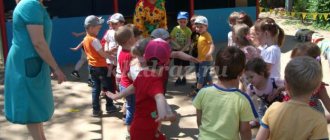Quiz on traffic rules in kindergarten: junior group
It is worth noting that in no case should you burden your child with an unnecessary amount of information, which is quite complex for him, and he will not remember it. Remember that information is best remembered in the form of games and quizzes, as well as educational materials. The very first mention of traffic rules should occur in the nursery group or junior preschool. First, you get acquainted with the traffic light.
Traffic rules in kindergarten
Traffic rules in kindergarten:
- A whole day is allocated for this. It is necessary for children to learn the order of colors on a traffic light and the meaning of each of them.
- To do this, you need to prepare in advance and print several circles of different colors on the printer. That is, it is red, yellow, green. Now you also need to depict a kind of corner reminiscent of a highway.
- It is necessary to display children's toy cars, a bus, and a trolleybus. It is necessary for children to say what it is. That is, this is a road and a highway, a carriageway.
- It is necessary to tell children that they cannot walk on the roadway; there are specially designated areas for this. At the very beginning, acquaintance is carried out from a traffic light.
- It is necessary to tell the kids that there are certain principles that all passengers, drivers, and pedestrians must follow.
- Tell the children who a pedestrian, a driver, and a passenger are. After this, it is necessary to reinforce the information that children must stand at a red light, get ready at a yellow light, and cross the roadway at a green light.
- It is best if one of the kindergarten staff, for example a nanny, pretends to be a traffic light. This can be a sewn model that is attached to the chest. It is necessary to ensure that the colors are removable.
- Thus, this will allow children to remember information faster and react faster to color changes. Now it is necessary for one of the teachers to take the children by the hand, and when the light turns green, walk across the road.
- It is necessary to use cubes to make a kind of fence and draw a pedestrian crossing, which is usually located at a traffic light.
- At this time, the traffic light should change colors. As soon as the light turns red, children must stop. As soon as the yellow light appears, children must stand still and stomp their feet. When they see green, the children move forward again.
- Now you need to distribute to the children pre-prepared cards with a black and white image of a traffic light. It is necessary for children to draw the arrangement of flowers from memory, using brushes and paints.
- It is best to use regular gouache and fairly thick brushes. The main task is for children to remember that at the very top there is a red light, then yellow, and at the very bottom green. As soon as the kids have done it, they need to dry these drawings and put them in a folder.
- Remember that the main task of this task is not only to remember the location of the colors on the traffic lights, but also their meaning. In addition, we teach children how to handle paints and brushes. This prepares the hand for writing and also develops imaginative thinking in children.
- After a sleepy hour, it is necessary to consolidate the acquired knowledge; it is best to do this while walking. To do this, there are several games with which you can consolidate the acquired knowledge.
- It is necessary to make a layout of the traffic light. You can make it from scrap materials. Attach red, yellow, green colors to the tree. Now one of the teachers removes two circles, leaving only one, for example red.
- Children must stand and remain silent. After this, the light is changed to yellow, the children continue to stand still and stomp their feet. As soon as the green light appears, the children continue moving.
- All this seems quite simple and elementary, but knowledge of all these colors must be instilled in children from early childhood. The most interesting thing is that children can really get confused even with the simplest things.
Traffic rules in kindergarten
You need to start studying with the simplest signs. This is a pedestrian crossing, there is no passage, or an underground or ground crossing. It is worth explaining to kids that when crossing a road, they must immediately look left, then right, then left again and not cross the roadway. Explain to children how to avoid trams, buses and other types of public transport.
Simple signs for children
Questions with answers on traffic rules for preschoolers
1 question:
Why should you cross the street only at intersections and on pedestrian paths?
Answer:
The driver knows that according to the rules pedestrians are allowed in these places, he drives carefully and reduces speed. A pedestrian who is not where he should be and can get hurt himself and interferes with the driver.
2.Question:
Why can't you cross the street when the traffic light is red or yellow?
Answer:
When the “red” light is on for pedestrians, the “green” light is on for drivers. Seeing a green light, the driver drives quickly and does not expect pedestrians. The red light is on for only a few seconds. Even if there are no cars, you have to resist the urge to cross and wait for the green light.
3.Question:
Why is it dangerous to cross the street?
Answer:
When a child runs, it is difficult for him to observe and see. Everything jumps and it takes a lot of energy. And when crossing the street, the main thing is to carefully watch both left and right, because often the street is deceptive: it seems safe, and suddenly a car drives out from an alley or from behind another car. Motorcycles are even harder to spot.
4.Question:
Why are bushes and trees on the streets dangerous?
Answer:
The danger of bushes and trees is that they also interfere with long-distance views of the street. A pedestrian looks through the bushes - there seems to be nothing. And a car might pass behind them1
5.Question:
Why can't you walk along the roadway?
Answer:
Even walking along the edge of the roadway is dangerous—you might get hit by a car. You only need to walk on the sidewalk.
6.Question:
How to walk on a road that has no sidewalk?
Answer:
When there is no sidewalk (outside a city or town or village), you need to walk along the side of the road facing the traffic, i.e. towards moving traffic - on the left side of the road in order to see those cars that are traveling towards you.
7.Question:
Is it dangerous for a child to see a friend or relatives on the other side of the street?
Answer:
Seeing friends or relatives, the child will be happy and want to quickly meet them across the street. At this time, he may not notice the cars driving down the street.
8.Question:
Why is it dangerous to cross the street together, arm in arm, or hold hands?
Answer:
When a whole column of children crosses the street, it is safe to hold hands. When two or three are crossing, there is no need to hold hands, and especially not arm in arm. Because when danger appears, children can begin to pull each other in different directions and lose the most valuable seconds. When crossing the street, only the little ones should be held by the hand.
9.Question:
What is more dangerous on the street: a pedestrian crossing without a traffic light or with a traffic light?
Answer:
Crossing without a traffic light is more dangerous, because you need to be able to determine whether a car is far or close, whether it’s driving fast or slow, and you need to be able to spot a small car or motorcycle. At the same time, often, because of a slowly moving car, another one is driving fast; because of the car that has passed, an oncoming car may leave. When the traffic light is just green - go, yellow or red - stop.
10.Question:
What is the danger for a pedestrian when one car overtakes another?
Answer:
At this time, one car drives out from behind another, the speed of the overtaking one is much higher. A pedestrian may not notice an overtaking car until it moves ahead, but then it will be too late. The driver of an overtaking car will also not see the pedestrian until he pulls out from behind the car he is overtaking.
11.Question:
In what places are pedestrians allowed to cross the street?
Answer:
Crossing the street is permitted only at intersections along the sidewalk line, at pedestrian crossings marked with lines on the roadway; in places indicated by the road sign “Pedestrian crossing”
12.Question:
Where is the safest place for pedestrians to be if they are overtaken by moving vehicles on the roadway?
Answer: Pedestrians who do not have time to cross the street (road) should wait in the middle of the roadway and carefully monitor passing traffic.
13.Question:
Is it possible to cross the street (road)?
Answer:
Pedestrians should cross the street at a walk, and not run across it, since if a pedestrian suddenly appears, the driver must immediately stop the vehicle and cannot avoid running into him.
14.Question:
How to properly cross a road where there is no traffic light, but there is a zebra crossing and a pedestrian crossing sign?
Answer:
Before crossing the street, a pedestrian must ensure complete safety. You must not cross the path of approaching traffic. The driver must give way when he sees a pedestrian near the “Pedestrian Crossing” sign
15.Question:
How to properly cross a roadway where there is a traffic light?
Answer:
If the red light comes on, it means you need to wait, it means “stop”. If the yellow light comes on, it means you need to get ready, and the green light means you can move on.
16.Question
: You need to get to school by bus. How will you do this?
Answer:
You need to wait for the bus where there is a “Bus Stop” sign. You need to enter the bus at the back door and exit at the front.
17.Question:
How should the driver and passengers behave on the bus?
Answer:
The bus has seats for children and disabled people. You need to give way to older people, don’t make noise, be polite, pay for the fare, and the driver must announce a stop, take your time and wait for passengers.
18.Question:
You finished your lessons at school and you decided to ride bicycles. Where and how will you do this?
Answer:
You can ride bicycles in the yard, on roads where there is a “Bicycle path” sign.
19.Question:
How should an adult and a child board the bus?
Answer:
The child enters first, the adult follows.
20.Question:
How should an adult and a child get off the bus?
Answer:
The adult goes out first and helps the child out.
21.Question:
What is a “safety island” and what is it intended for?
Answer:
Now there are no islands of safety.
22.Question:
How to properly transport a child in a car?
Answer:
Transportation of children under 12 years of age in vehicles equipped with seat belts must be carried out using special child restraints appropriate for the weight and height of the child, or other means that allow the child to be fastened using seat belts provided for by the design of the vehicle, and in the front seat passenger car - only with the use of special child restraints.
23.Question:
Why is it necessary to be at some distance from the roadway at bus stops, especially in wet weather, to watch for approaching traffic?
Answer:
If the stop area is wet, you can slip and get hit by stopping vehicles. On a slippery roadway, a vehicle may skid onto the site or sidewalk.
24. Question:
How should you cross the road with a child if there is no pedestrian crossing?
Answer:
It is allowed to cross the street at a right angle, where it is clearly visible in both directions. It is allowed to enter the roadway only after pedestrians are convinced that the crossing is safe. Hold the child firmly by the wrist so that the child does not pull his hand away.
25.Question:
What is the correct way to cross the road after getting off the bus?
Answer:
We have to wait until the bus leaves. Look carefully on both sides of the road and then cross. And if there is a marked pedestrian crossing nearby, you need to cross only along it.
municipal preschool educational autonomous
institution kindergarten No. 7 in the city of Svobodny
(MDAU d/s No. 7, Svobodny)
Methodological recommendations for holding “minutes”
on the prevention of accidents with children on the street.
Svobodny
year 2014.
"Just a minute"
- This is a short-term activity - a traffic safety reminder.
The purpose of the "minute"
- with an entertaining short story, divert the attention of children to issues related to safety, at the same time telling them any useful information so that when leaving school the street itself, to one degree or another, reminded the children of the danger and the need for caution when moving along the street . The teacher begins the “minute” with some phrase, for example: “Now children, let’s learn how not to get hit by the wheels of a car,” or another phrase. Students are then asked a question from the questionnaire.
Every day a new question is discussed, after listening to the answer of one or two children, the teacher corrects them and gives his explanation if the children answered incorrectly or the answer was incomplete.
Traffic rules in kindergarten: quiz for the middle group
For children aged 4-5 years, it is necessary to expand knowledge and add additional information. Enter the concepts of traffic light, zebra crossing, pedestrian crossing, children on the roads, travel prohibited, underground passage, tunnel. The quiz is held in the music room, best done with music; you can use not a piano, but a regular disk and flash drive.
Traffic rules in kindergarten
Traffic rules in kindergarten:
It is necessary that the host of this quiz be the author and the invited guest. It could be some interesting animal, for example, a Rabbit. The presenter comes out and tells that today a very interesting, unusual guest came to the children, who loves to walk where he likes.
The presenter asks the Rabbit: Before crossing the road, do you look both ways?
Krol says: No.
The presenter asks him: Do you know the traffic rules?
The rabbit denies again.
Traffic rules in kindergarten
Presenter: Rabbit, why aren’t you afraid that you’ll get hit by a car?
The rabbit says: I'm not afraid of anything, I'm brave.
Presenter : Children, let us tell the Rabbit how to behave on the road.
Beware of the Car begins . In this case, it is necessary for each child to give the steering wheel in his hands. At the same time, the Rabbit runs away from the children, and the kids chase after him. A kind of chaotic movement is created. When the music stops, the children return to the parking lot.
Traffic rules in kindergarten
the rabbit says: Eli ran away, the car almost hit me.
The presenter answers: That's right, Rabbit, so you must adhere to the traffic rules and cross the road only in clearly designated areas.
The rabbit answers her: How can I understand that it is necessary to cross the road in this particular place? Are there any identifying marks?
Presenter : Children, show the Rabbit in which places it is necessary to cross the road.
In this case, each child is given a piece of white or black paper. Children must take turns building a zebra using the strips of paper they received.
Traffic rules in kindergarten
The presenter says: Rabbit, this is a zebra, and the children show that it is necessary to cross the road on a zebra.
A rabbit crosses the road directly at a zebra crossing.
After this, the Leader says to the children: Kids, show the Rabbit how to cross the road on a zebra.
You need to put a large tunnel in the middle of the hall, the music is turned on, the kids climb through this soft tunnel. On the other side of the room, they return along the zebra crossing.
Traffic rules in kindergarten
Now the Rabbit says : Well, the guys surprised me, now I will know where to cross the road.
After this, it is necessary to bring a “Children on the Road” sign into the music room. It is necessary to divide the children into several teams. Give some children a steering wheel and they will become cars. And other children will run across the road. In this case, it is necessary that cars stop when they see the “Children” sign.
Rabbit says : Well, now I've learned a little about the rules of the road. However, what to do if there are no pedestrian crossings or zebra crossings?
Here comes the traffic light. This could be a teacher in a red hat, a yellow T-shirt and green pants. That is, a kind of imitation of a traffic light.
Quiz with kids
Traffic light : I am Traffic Light, I regulate traffic on the roads. Children, who can tell me how to cross the road at a traffic light?
In this case, it is necessary that one of the children answer that on red you need to stand, on yellow, get ready, and on green, cross the roadway.
Rabbit: Thank you children, now I know everything, and I will no longer run where I shouldn’t, I’m very afraid of being hit by a car.
Traffic rules in kindergarten
Do children need traffic rules?
According to WHO, more than 2 thousand children are injured or killed on the roads every day. This is largely due to ignorance of the rules of behavior on the street. Therefore, there is only one answer - knowledge of traffic rules is simply necessary for children, and the task of adults is to teach them both in the family and at school the “ABC of the Road”.
Primary school students must learn rules containing the following provisions:
- you should cross the road using special markings, following the traffic lights,
- cycling is carried out in accordance with the requirements,
- travel by category B vehicle is organized by adults,
- You should know the meaning of common road signs.
You can practice skills using game methods. Dramatizations, riddles, puzzles, crosswords, and Olympiads will come in handy. The traffic rules quiz will be very interesting for children of all ages.
Traffic rules for preschoolers: a game for older children
Similar games and quizzes are also held for children of senior preschool age. During these games, it is necessary to consolidate and test children’s knowledge of traffic rules. Before this, it is necessary to carry out work several times, distribute coloring books, and learn poems and songs regarding traffic rules.
It is necessary for children to enter the music room. To play the game you will need the evil hero Blob, as well as a Traffic Light and a Presenter.
Traffic rules in kindergarten
Traffic rules in kindergarten:
The presenter says : We have received a letter from residents of the country of road signs, they write that they have been faced with a great misfortune. The blot painted all the road signs, stole the traffic light, and ruined all the pedestrian crossings and zebra crossings. Now the country is in danger, because the cars don’t know how to move, and there is real chaos on the roads. Children, let's help the country of road signs restore justice and put everything in its place.
Children come in and sit on chairs.
At the same time, the negative hero Klyaksa says : Well, who will help the signs if there is no one here except the kids?
Presenter: The kids will help.
Klyaksa: Oh, they made me laugh, they don’t know anything.
The presenter addresses the children : Kids, let's tell this arrogant girl that we really learned the rules of the road and can restore everything.
Children shout : Let's help.
Traffic rules in kindergarten
They bring out a “Children on the Roads” sign cut into several pieces. A team of six children is selected, and another team is taken on to assemble the second “No Bicycles” sign. It is necessary for children to assemble a kind of puzzle from cut pieces of pictures. As soon as the children cope, the game stops.
Klyaksa says : Oh, I didn’t expect from these kids that they were so smart, that they really understood signs. Let them tell me what these signs are and how to behave when they see them on the roads.
One child stands up and talks about the sign “Children on the roads,” and the second about the sign “No bicycles allowed.” After this, the game continues.
Traffic rules in kindergarten
Klyaksa: What to do? I returned the signs to you, but you still won’t be able to cross the road without a traffic light and signs.
The presenter says to the children: Let's tell her where to cross the road.
The child gets up and talks about the need to travel exclusively on the zebra crossing. The second child tells how to cross the road.
Klyaksa says : Okay, I’ll return the zebra to you, but I spoiled it a little.
He brings out a box with white and black strips cut into pieces. It is necessary that the children quickly line up the zebra. It is best to divide the kids into two groups and do something in the form of a relay race. It is necessary for children to assemble the zebra at speed. So the team that wins gets a prize.
Traffic rules in kindergarten
Klyaksa says: Okay, now you have a Zebra, but how can cars drive without a traffic light? What difference does it make, you still don’t know how to handle it.
The presenter says : Children, let's tell the blot what a traffic light is and how to handle it.
Children of one team are given mugs; the children must take turns lifting them. The second team stands at the other end of the room, and as soon as the children raise the red circle, the members of the second group must sit on a chair. If the children pick up the yellow circle, then the second team stands next to their seats. As soon as the children pick up the green circle, the kids walk in place. It is necessary to alternate colors several times so that the children either walk, or simply stand, or sit in their places.
Klyaksa says: Okay, you persuaded me, I’m returning the Traffic Light to you.
Traffic light comes out, you can diversify the holiday by dancing with steering wheels. To do this, each child is given a model of a steering wheel. For this, flexible wire covered with foam rubber and black fabric can be used. After this, the children sit down in their places, the holiday ends with a sweet table.
Traffic rules in kindergarten
There is a huge amount of materials for quizzes for children aimed at memorizing traffic rules. Choose the most interesting materials; under no circumstances do you cram theory with your children. It is best to present these rules in the form of games and fun quizzes.







